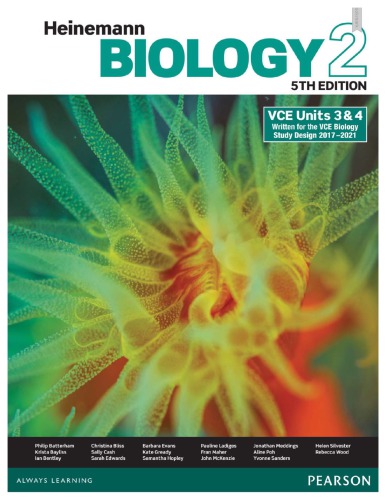Title: Heinemann Biology 2 | Author(s): Philip Batterham, Christina Bliss, Ian Bently, Christina Bliss, Sally Cash, Sarah Edwards, Barbara Evans | Publisher: pearson | Year: 2017 | Edition: 5e | Language: English | Pages : 697 | Size: 173 MB | Extension: pdf
- Unit 3: How do cells maintain life?
- Area of study 1: How do cellular processes work?
- Area of study 2: How do cells communicate?
- Unit 4: How does life change and respond to challenges over time?
- Area of study 1: How are species related?
- Area of study 2: How do humans impact on biological processes?
- Chapter 1 Biology keystones – foundation skills
- 1.1 The scientific method
- 1.2 Planning investigations
- 1.3 Conducting investigations
- 1.4 Data analysis and presentation
- 1.5 Reporting investigations
- Chapter 2 Cells and composition of cells
- 2.1 Cells
- 2.2 Molecular composition of organisms
- 2.3 The plasma membrane
- 2.4 Movement of material across membranes
- 2.5 Proteins
- Chapter 3 Nucleic acids, gene structure and regulation
- 3.1 Nucleic acids – DNA and RNA
- 3.2 Gene structure and gene expression
- 3.3 Gene regulation
- Chapter 4 Enzyme regulation in biochemical pathways
- 4.1 Enzymes and biochemical pathways
- 4.2 Regulation of enzymes
- Chapter 5 Energy transformation in cells
- 5.1 Photosynthesis
- 5.2 Factors that affect the rate of photosynthesis
- 5.3 Cellular respiration: Glycolysis
- 5.4 Cellular respiration: Aerobic and anaerobic respiration
- 5.5 Factors that affect the rate of cellular respiration
- Area of study 1 review
- Chapter 6 Cellular signals
- 6.1 Signalling molecules
- 6.2 Signal transduction
- 6.3 Apoptosis
- Chapter 7 Responding to antigens
- 7.1 Antigens
- 7.2 Innate immunity
- 7.3 Adaptive immunity
- Chapter 8 Immunity, immune malfunctions and immunotherapy
- 8.1 Immunity
- 8.2 Diseases of the immune system
- 8.3 Cancer immunotherarpy
- Chapter 9 Changes in the genetic make up of a population
- 9.1 Changing allele frequencies
- 9.2 Processes of evolution
- 9.3 Selective breeding
- Chapter 10 Changes in biodiversity
- 10.1 Significant changes in biodiversity over time
- 10.2 Evidence for evolution
- 10.3 Patterns of biological change over time
- Chapter 11 Determining relatedness between species
- 11.1 Molecular homology
- 11.2 Phylogenetic trees
- 11.3 Developments in evolutionary biology
- Chapter 12 Human changes over time
- 12.1 Defining humans
- 12.2 Patterns in hominin evolution
- Area of study 1 review
- Chapter 13 DNA manipulations: PCR, gel electrophoresis, DNA transformations
- 13.1 DNA manipulation
- 13.2 Bacterial transformation
- Chapter 14 Biological knowledge and society
- 14.1 Applications of DNA technologies
- 14.2 Genetically modified and transgenic organisms
- 14.3 Strategies to deal with emerging new diseases
- 14.4 The use of chemical agents against pathogens and rational drug design
- Area of study 2 review


